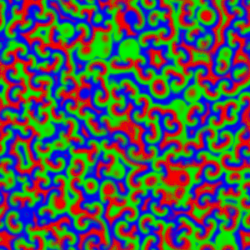This article relies largely or entirely on a single source. (June 2015) |

Spatiotemporal patterns are patterns that occur in a wide range of natural phenoma and are characterized by a spatial and temporal patterning. The general rules of pattern formation hold. In contrast to "static", pure spatial patterns, the full complexity of spatiotemporal patterns can only be recognized over time. Any kind of traveling wave is a good example of a spatiotemporal pattern. Besides the shape and amplitude of the wave (spatial part), its time-varying position (and possibly shape) in space is an essential part of the entire pattern.
The distinction between spatial and spatio-temporal patterns in nature is not clear-cut because a static, invariable pattern will never occur in the strict sense. Even rock formations will slowly change on a time-scale of tens of millions of years, therefore the distinction lies in the time scale of change in relation to human experience. Already the snapshot state of a dune will usually be taken as an example of a purely spatial pattern although this is clearly not the case. It is thus apt to say that spatiotemporal patterns in nature are the rule rather than the exception.